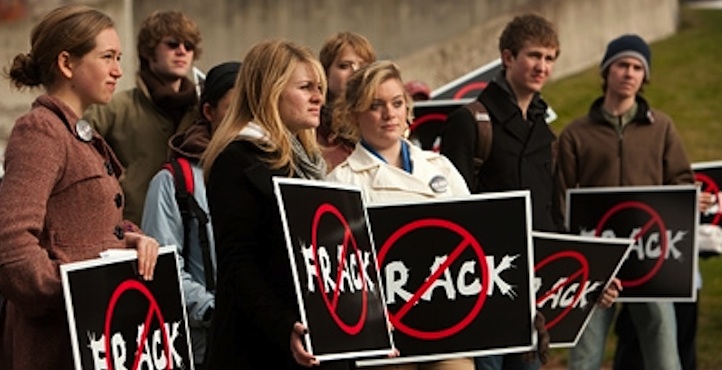
In a rush to keep developing more natural gas and oil, oil and gas companies are relying more heavily on a technique of stimulation and extraction known as hydraulic fracturing or fracking. Using this process, companies that develop gas and oil wells pump very high-pressure water, chemicals and solids into the ground to fracture rock and extract fuel that would otherwise be unavailable.
Though some form of fracking has been used for more than 50 years, its recent rise has raised a number of environmental and safety/health concerns including the release of greenhouse gases, contamination of drinking water, air pollution and triggering earthquakes. These concerns are raised in light of weak international, federal and state oversight and regulation of the process—with federal standards even weaker than those of many states.
The Angeles Chapter of the Sierra Club is concerned about the introduction of large-scale fracking and similar processes to Southern California. About 9 million people call our area home. They live in a region that has a growing dependency on groundwater, has a robust seismic record with many earthquake faults believed to still be undiscovered, boasts some of the nation’s
worst air quality, and is riddled with gas and oil fields from the heyday of drilling, with many abandoned wells remaining uncapped.
Energy and petroleum interests say there’s no evidence of any direct, negative environmental impact of fracking, and the practice has decades of use without problems, but without any documentation of underground environmental conditions before/after wells and fields developments.
A national issue
But that’s not what many communities say. Sierra Club chapters in New York-Pennsylvania, Ohio, Arkansas, Texas, Colorado, Wyoming and other communities have raised concerns – and received few answers. In Ohio, an area not known for earthquakes, state regulators say a dozen recent earthquakes were almost certainly caused by injection of gas-drilling wastewater into the earth near Youngstown. The largest measured 4.0 on the Richter Scale, caused cracks to appear in some streets and was felt as far away as Toronto.
Fracking is also blamed on another 50 earthquakes in Ohio and two in England, and others have been acknowledged by well service companies. Locally, Baldwin Hills and Culver City residents are up in arms about a process being used at the nearby Inglewood Oilfield, and the impact it could have on their communities. Plains Exploration and Petroleum (PXP) says in media stories that it uses high-rate gravel packing not hydraulic fracturing, although reports to the Division of Oil, Gas & Geothermal Resources indicate that they did fracking.
Residents want to know about any process that pumps at very high pressure liquids or slurries into the ground and what could happen as a result. Fracking uses its brew to fracture
tight rocks to promote gases, oil, and water to flow through new cracks to a well where they can be extracted. Current methods use large volumes of water, a wide range of hazardous chemicals, fine sand and very high pressures with complex equipment array to reach down nearly a mile to get more oil and gas out of the rocks.
Neither state nor federal regulations compel energy companies to disclose substances, quantities, or the process they pump into the ground to stimulate the extraction process. The California legislature has responded by drafting various legislation requiring its disclosure of fracking locations, processes, and chemicals. California regulators are concerned with ‘active fault zones.’ but they say nothing about the other potentially ‘active’: ‘ancient’, ‘inactive’, and other faults, fractures, and joints in the ground beneath us here in the greater Los Angeles metropolitan area.
Fracking is done on a variety of newly drilled, existing, idled, or can even done on abandoned wells. Fracking is generally used for “tight” brittle formation (hence: “Shale Gas” or “Shale Oil”) where the fracturing promotes cracks and increases formation flow and would not be used for softer, loose sands, such as normal producing reservoirs or deep-well injection for disposal. Fracking is sometimes called by other terms: “well-rework,” “well completion,” “well development,” “well stimulation,” “chemical injection,” “acid-injection,” “frack-packing,” and “steam-fracking” to avoid “The f-word.”
In addition to greenhouse gases and toxic pollution caused by burning fossil fuels, production of oil and gas releases its own substantial share and increased fracking is reported to release even more gases. EPA recently announced new regulations for all emissions from oil and gas wells from drilling to production. Methane in natural gas, is 20 times more potent as a greenhouse gas than carbon dioxide. Methane, along with toxic gases, is released in the fracking process.
New EPA rules on the way
The U.S. Environmental Protection Agency is studying fracking and related processes to prepare regulations to oversee these operations. The California Division of Oil, Gas and Geothermal Resources has laws on the books that provide adequate scope for documentation and controls of fracturing as part of their permitting and regulations for drilling new wells and for reworking of existing wells if the Division of Oil, Gas & Geothermal Resources requires to do so. The division now says it will await guidance from the state Legislature, which is mulling two-plus bills on fracking.
For onshore federal lands, Sierra Club and the Center for Biological Diversity have sued the Bureau of Land Management to establish real regulations, which could become onshore models for all BLMs and the EPA. However, for many environmental issues arising from oil and gas fields, the state oil and gas division says it doesn’t have jurisdiction over water or gas emissions (Regional Water Quality Control Board and Air Quality Management District) once they leave the well head.
For more positive trends, the state division has not opposed county ordinances managing activities within oil fields in Los Angeles, Santa Barbara, San Luis Obispo and Monterey. In contrast, Kern County does not involve itself with any controls of energy companies and activities.
Photo: Protesters in other parts of the country have been demonstrating against fracking. Credit: Jason Koski